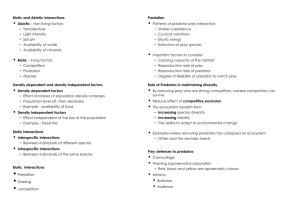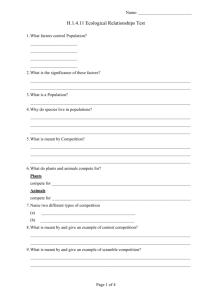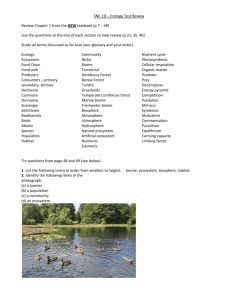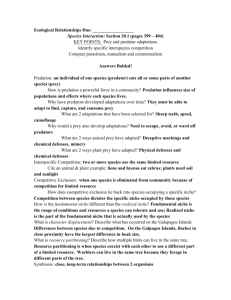Final Exam
advertisement
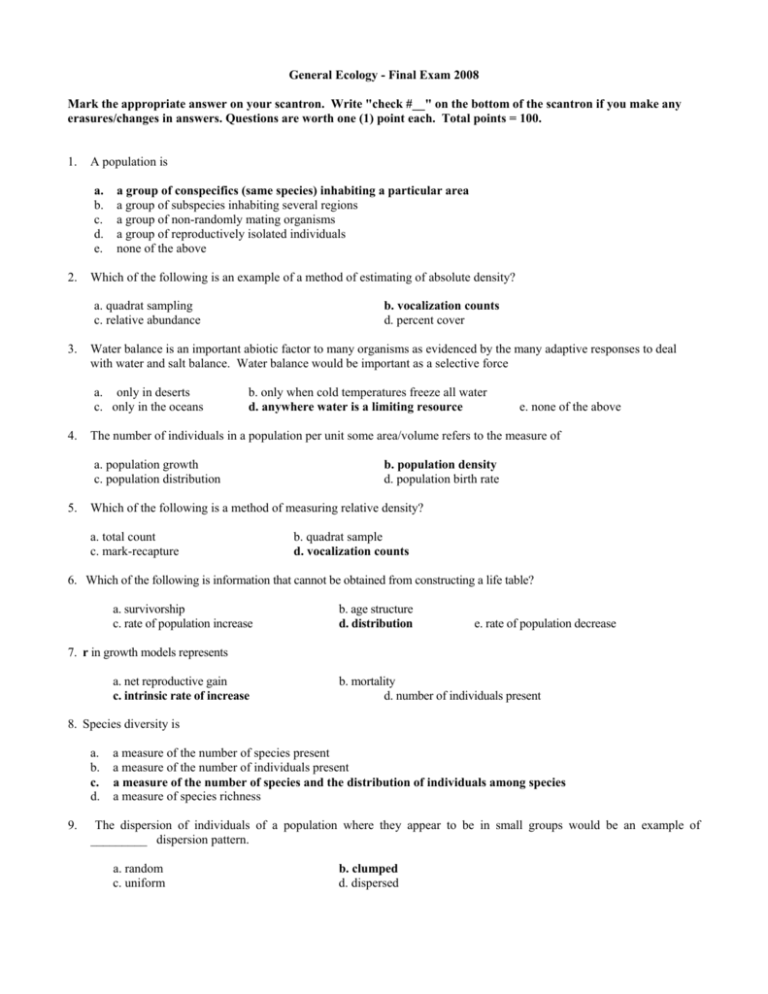
General Ecology - Final Exam 2008 Mark the appropriate answer on your scantron. Write "check #__" on the bottom of the scantron if you make any erasures/changes in answers. Questions are worth one (1) point each. Total points = 100. 1. A population is a. b. c. d. e. 2. a group of conspecifics (same species) inhabiting a particular area a group of subspecies inhabiting several regions a group of non-randomly mating organisms a group of reproductively isolated individuals none of the above Which of the following is an example of a method of estimating of absolute density? a. quadrat sampling c. relative abundance 3. Water balance is an important abiotic factor to many organisms as evidenced by the many adaptive responses to deal with water and salt balance. Water balance would be important as a selective force a. only in deserts c. only in the oceans 4. b. vocalization counts d. percent cover b. only when cold temperatures freeze all water d. anywhere water is a limiting resource The number of individuals in a population per unit some area/volume refers to the measure of a. population growth c. population distribution 5. e. none of the above b. population density d. population birth rate Which of the following is a method of measuring relative density? a. total count c. mark-recapture b. quadrat sample d. vocalization counts 6. Which of the following is information that cannot be obtained from constructing a life table? a. survivorship c. rate of population increase b. age structure d. distribution e. rate of population decrease 7. r in growth models represents a. net reproductive gain c. intrinsic rate of increase b. mortality d. number of individuals present 8. Species diversity is a. b. c. d. 9. a measure of the number of species present a measure of the number of individuals present a measure of the number of species and the distribution of individuals among species a measure of species richness The dispersion of individuals of a population where they appear to be in small groups would be an example of _________ dispersion pattern. a. random c. uniform b. clumped d. dispersed 10. Which of the following is not an adaptive advantage for larger body size? a. b. c. d. less susceptible to predation shorter generation time more opportunities to reproduce successfully longer lived 11. True (A)/False (B): The competitive exclusion principle explains why it is difficult to see active competition in nature. 12. True (A)/False (B): Grouping behavior is a behavioral adaptation seen in predator and prey species. 13. The logistic (sigmoidal) model of population growth places a constraint on population size. This constraint, determined primarily by the availability of resources and representing the maximum number of individuals that can be supported within a population, is called a. No c. intrinsic rate of increase b. carrying capacity d. survivorship capacity 14. A species that is heavily preyed on and is susceptible to disease early in its life cycle but becomes less susceptible to predation and disease once its reaches an age of 10 months (within a life cycle of, say, 6 years) is most likely to exhibit a ______________ survivorship curve. a. Type I c. Type III b. Type II d. bird-rotifer 15. You are studying an organism with a life span of 3 months. The best approach for obtaining the best life table information on this species would be to use age intervals comprised of a. hours c. months b. days d. years 16. A life table that follows the individuals born at the same time throughout their life cycle is a ____________ life table. a. static c. sibling b. age d. cohort 17. Species diversity is of value to humans a. b. c. d. e. as a source of medicine as a source of useful generic variation to maintain stability of systems a and b a, b, and c 18. The model of population growth that examines the rate of population growth without constraints is called a. exponential model c. Lotka-Volterra model b. logistic model d. deterministic model 19. Batesian mimicry occurs when a. c. noxious species resemble one another benign species resemble noxious species b. benign species resemble one another d. none of the above 20. True (A)/False (B): Mutualism is an interactive relationship where both species receive some positive benefit from the interaction. 21. The roots of ecology as a science developed from a. chemistry c. environmental biology b. physics d. natural history 22. A group of two or more populations in a given area describes a a. population c. ecosystem b. community d. biotope 23. The environmental (non-living) components of an ecosystem are called the ______ components. a. abiotic c. ecological b. biotic d. physical 24. During its early stages of development, ecology was primarily a _______ science. a. c. analytical descriptive b. experimental d. quantitative 25. The area of ecology that deals with the study of individuals and how they relate to the environment is a. synecology c. autecology b. system ecology d. population ecology 26. Speciation that occurs through the movement of individuals of a population to a new habitat while not being geographically isolated from the parent population is called a. parapatric c. disruptive b. sympatric d. allopatric 27. Which of the following is not an example of a prezygotic isolating mechanism? a. mechanical incompatibility c. reproductively active at different times b. sterile hybrid d. does not recognize behavioral displays 28. The range of conditions that an individual can survive for a given environmental factor is called a. range of optimum c. range of survival b. range of tolerance d. tolerance limit 29. True (A) or False (B): Periods where temperatures are in excess of the range of tolerance of a species for only a brief period of time will not result in the exclusion of a species from that habitat. 30. Which of the following is not an example of coping with environmental change? a. increasing prey consumption c. hibernation b. migrate d. aestivation 31. Which of the following is a critical/essential component for natural selection to proceed? a. b. c. d. a large number of individuals in a population variation for key traits in the gene pool a species with a broad geographic distribution speciation 32. Which of the following is not an example of an abiotic factor? a. climate c. temperature e. all are abiotic factors b. water content d. vegetation 33. Homeostatic mechanisms a. cost energy c. do not affect the energy budget e. none of the above b. save energy d. use energy from the environment 34. True (A) or False (B): Organisms in the zone of physiological stress of their range of tolerance for a limiting factor tend to exhibit poor growth and have reduced reproductive rates. 35. Density independent factors a. are more likely to affect homeotherms c. are the result of abiotic effects e. all of the above b. always result in population declines d. are the result of biotic effects 36. Clutch sizes are not always maximized (produce the most offspring possible) by selection because a. survival of large clutches may be lower c. selection can not act upon clutch size b. parental survival increases with clutch size d. of accumulation of mutations 37. Organisms with a type III survivorship curve a. may not reproduce if they wait to get larger b. cannot reproduce until mortality in the population stabilizes c. face selection for more parental care d. are selected for many, small reproductive events 38. In chaos theory a. populations are equally likely to go extinct c. populations are never at equilibrium b. populations always change at random d. small changes in initial conditions have large effects 39. Interaction between individuals of different species, brought about by a shared requirement for a resource in limited supply, and leading to a reduction in the survivorship, growth, and/or reproduction of the competing individuals is called a. commensalism c. predation b. interspecific competition d. intraspecific competition 40. The concept of keystone predators combines attributes of the ecological principles of ________ and ___________ (select the most appropriate combination) a. competition and population size c. predation and competition b. species diversity and autoecology d. predation and adaptation 41. True (A) or False (B): Global climate change has serious implications because global climatic patterns influence the location of specific types of terrestrial habitats (e.g., deserts, rainforests). Shifts in global climate patterns would have serious implications as to the location or even survival of many of these environments. 42. Our current interpretation of niche as an n-dimensional hypervolume and as a quantifiable entity was proposed by a. Lotka-Volterra b. Hutchinson c. Elton d. Grinnel 43. Introducing a species to a habitat where it did not originally occur (such as zebra mussels or purple loosestrife) a. b. c. d. will always lead to the local extinction of the introduced species may allow them to escape factors that regulated them in their native habitat will eventually result in equilibrium for all species involved will never have adverse effects on the new habitat 44. r-selected organisms are typically viewed as organisms that colonize a new habitat early because a. they reproduce rapidly c. they do well in stable environments b. they outcompete K-strategists early d. they achieve large body size 45. Which of the following is not associated with K selection? a. type I survivorship c. iteroparity e. none of the above b. low juvenile survival d. extended parental care 46. Probably the only underlying theory in ecology is a. Hardy-Weinberg c. laws of physics b. evolutionary d. ecological principles 47. Allele frequencies can change as a result of a. natural selection d. gene flow b. genetic drift e. all of the above c. mutation 48. Net primary production is a. gross primary production - respiration c. gross primary production used for reproduction b. gross primary production + respiration d. respiration during daylight 49. True (A) or False (B): Natural selection, in some instances, can lead to the introduction of new alleles for some characteristics. 50. The mode of natural selection that selects against one extreme of a population is called _____ selection. a. stabilizing c. disruptive b. directional d. drift 51. Specifically, application of the Hardy-Weinberg theorem in the examination of the genetic make-up of a population provides us with a means of a. b. c. d. determining the allele frequencies of a changing population examining the genetic make-up of a population in flux demonstrating that the genetic makeup of a population is at equilibrium in the absence of evolutionary change determining how natural selection acts to change a population 52. An adaptation is a. b. c. d. a feature of an organism that increases its fitness a change in the genotype frequencies resemblance to another species none of the above 53. Experiments testing island biogeography have found that _____________ after completion of the experiment. a. number of species and community composition have remained the same b. number of species and community composition both change c. number of species stays the same but community composition is different d. number of species changes but community composition stays the same 54. True (A) or False (B): Speciation is the only possible outcome of natural selection. 55. Which of the following is a plausible reason for high tropical species diversity? a. absence of biotic interations c. area effect b. environmental stability d. just because they tend to be at the equator 56. Which of the following would you expect to be of minimal importance in the shaping species diversity found in a given community? a. genetic variation c. habitat variation e. none are important b. climatic variation d. all of the above are important 57. True (A) or False (B): All scientists who support the nonequilibrium view of community structure feel that competition and predation play absolutely no role in shaping community structure. 58. Which of the following is the most likely way in which changes in niche dimension might be used to account for changes in community structure when a large number of the species appear to be generalists for a given resource? a. increased niche overlap b. decreased niche breadth c. increased range of resources used 59. The view that predation and competition are the key structural forces shaping community structure is the _______ view. a. nonequilibrium c. equilibrium b. disturbance d. biotic 60. Prey adaptation to avoid capture a. would depend on the nature of the predator c. includes the numerical response b. includes the functional response d. none of the above 61. In optimal foraging, time maximizers a. are not limited by energy c. live in seasonal environments b. are constrained by needs other than energy d. none of the above 62. The predator isocline of the graphical portrayal of the Lotka-Volterra predation model represents a. b. c. d. the number of prey needed to reach before predator numbers begin to increase the number of predators needed to reach before prey numbers begin to increase the number of predators needed to reach before prey densities stabilize none of the above 63. Keystone predators commonly a. increase the intensity of competition c. prey on species at random b. prey on the poorest competitors d. prevent competitive exclusion 64. The equilibrium theory of island biogeography proposes that in a situation where there are two islands of the same size but are different distances from the mainland, the equilibrium number of species will be greater for the island because THREW OUT a. immigration rate to the large island will be higher and extinction rate lower b. both the immigation and extinction rate to the large island will be higher c. immigration rate to the large island will be lower and extinction rate higher d. both the immigation and extinction rate to the large island will be lower 65. True (A) or False (B): Changes in niche dimensions (e.g., overlap, breadth) resulting from interspecific competition can only occur as a result of resource partitioning. 66. The process where the phenotype of a characteristic of two species diverges to reduce competition is called a. resource parceling c. character displacement b. character reallocation d. spatial partitioning 67. Bryozoans and freshwater sponges are both sessile organisms that require a firm substrate for attachment. When found together, sponges will overgrow and choke out the bryozoans. This is an example of what kind of competition? a. resource competition c. intraspecific competition b. exploitation competition d. interference competition 68. In the definition of the niche as a hypervolume, the n in n-dimensional refers primarily to the number of a. niches c. habitat variables b. species d. overlaps 69. r and K selection a. does not apply to asexual species c. is invalid because of bet-hedging b. can occur within a single species d. represent optimal and non-optimal strategies 70. The Lotka-Volterra models of competition predict coexistence of two species if a. overlap is large c. K is small for one species and large for the other b. K is small d. overlap is small 71. Several different species using the same area for feeding at the same time but occupying different subunits of the area would be an example of a. intraspecific competition c. character displacement b. resource partitioning d. niche breadth 72. A search image a. allows a prey item to recognize its predator c. applies only to visual predators b. prevents crypticity d. depends on predator learning 73. Which of the following would be excluded in a narrow definition of predation (as used in our discussion of models and concepts)? Consumption of THREW OUT a. live plant material by herbivores b. live animal matter c. dead animal material d. all of the above 74. Which of the following would you most likely expect to see in a community with a large number of specialist species? a. large niche overlaps c. large niche breadth b. small niche breadths d. increased ranges of resources 75. Which of the following is not an acceptable means of estimating primary production? a. biomass standing crop c. carbon-14 uptake e. all are acceptable b. oxygen production d. carbon dioxide uptake 76. Metamorphosis has advantages as a life history strategy, because different developmental stages in the life cycle can function in a. resting b. reproduction e. all of the above b. dispersal d. feeding 77. Species with different evolutionary histories that resemble one another are said to have undergone a. convergent evolution c. coevolution b. disruptive selection d. soft selection 78. You have a data set on the number of individuals for a single species over a 23-yr period. You note that the number of individuals in the population declines every year regardless of how many individuals are present during that year. You publish your data and years later, find that it is being used as an example of population regulation in a textbook. It would most likely be used to support which school of population regulation? a. intrinsic biotic c. abiotic b. extrinsic biotic d. metapopulation 79. According to the optimal diet theory of MacArthur and Pianka, when a predator is in a situation where the Ei/hI of potential new prey is low, a predator will tend to have a. a very specialized diet c. will go to a new patch b. a broad diet d. will stay in its old patch 80. Scientists try to model nature to a. b. c. d. find definitive models for a given process for every species find definitive models that are applicable to every possible set of conditions find models that are general enough to be broadly applicable find models that are general enough to not relate to the real world 81. True (A) or False (B): Carrying capacity is not a factor in depicting changes in population size when the Lotka-Volterra predation models are used. 82. Places in the world where the average annual amount of solar radiation reaches the surface is highest are not locations of high primary production because these same areas often also experience a. low temperatures c. high snowfall b. low precipitation d. high herbivory 83. True (A) or False (B): A community dominated by a small number of r-selected species most likely occurs in a habitat that is subjected to frequent disturbance. 84. It is common for organisms that produce multiple clutches each year to increase the number of individuals per clutch with increasing latitude. Based on what we know about changes in the physical features of mammals as you go from the equator to the poles, increases in clutch could be a result of a. increased body size of the female c. compensate for reduced mortality e. b and c are possible b. compensating for fewer clutches per season d. a and b are both possible 85. In small-scale irregular fluctuations a. the carrying capacity is not exceeded c. population size varies by a factor < 10 b. populations are constant d. populations are found in very small areas 86. Life history strategies a. are conscious tactics of an organism c. are all dependent on the size of an organism b. have no genetic basis d. are adaptive tactics 87. Which of the following is most accurate? Small organisms a. are always outcompeted by large ones c. tend to have shorter generation times b. always outcompete large organisms d. have long life spans 88. Refer to Figure 1. The relationship shown is representative of a population that is under _____________ regulation. a. density-independent c. density-neutral b. abiotic d. density-dependent 89. Refer to Figure 2. At point A, species diversity of a community at this point in the spectrum would be a. high due to competition c. low due to high disturbance b. low due to predation d. optimal 90. Refer to Figure 3. The distribution of the number of species present in this figure is largely influenced by a. predation c. disturbance e. none of the above b. competition d. climate 91. Refer to Figure 4. This depicts a population that is exhibiting what kind of change in population size a. exponential c. nonequilibrium b. Type I d. logistic 92. Refer to Figure 5. In this model of the Lotka-Volterra competition models, the outcome of competition would be a. species 1 wins c. stable equilibrium b. species 2 wins d. unstable equilibrium 93. Refer to Figure 5. The overlapping lines shown in the figure refer to the ________ of each species a. mortality rate c. competition rate b. birth rate d. carrying capacity 94. Refer to Figure 6. Which of the species depicted is exhibiting a functional response to increased prey availability? a. Blarina c. Sorex b.Peromyscus d. none of the above 95. Refer to Figure 2. This figure is a graphical portrayal of which ecological model? a. Lotka-Volterra competition c. intermediate disturbance b. exponential growth d. range of tolerance 96. Refer to Figure 7 showing Lotka-Volterra predation model. The dot represents the initial population size at time zero. If we were to track the two populations from this point, the expected trend during the early period (this quadrant only) would be for a. predators increase, prey decrease c. predators decrease, prey decrease b. predators increase, prey increase d. predators increase, prey increase 97. The inclusion of disturbance in the modern definition of succession illustrates the integration of succession and a. b. c. d. species diversity intermediate disturbance hypothesis keystone species theory of island biogeography 98. True (A)/False (B): We discussed how succession is not necessarily linear. This can also apply to the starting point for succession of a plant community because abiotic conditions will influence what the composition of the community at the start of the successional process looks like. 99. True (A)/ False (B): The heterogeneity of habitat types contributes to greater species diversity within ecosystems displaying this attribute. 100. According to the equilibrium theory of island biogeography, which of the following situations would lead to a faster colonization rate? a. large island far from mainland c. large island close to mainland birth rate/death rate Figure 1 Population Size (N) b. small island close to mainland d. small island far from mainland Figure 2 A Figure 3 Figure 4 Figure 5 Figure 6 Figure 7






